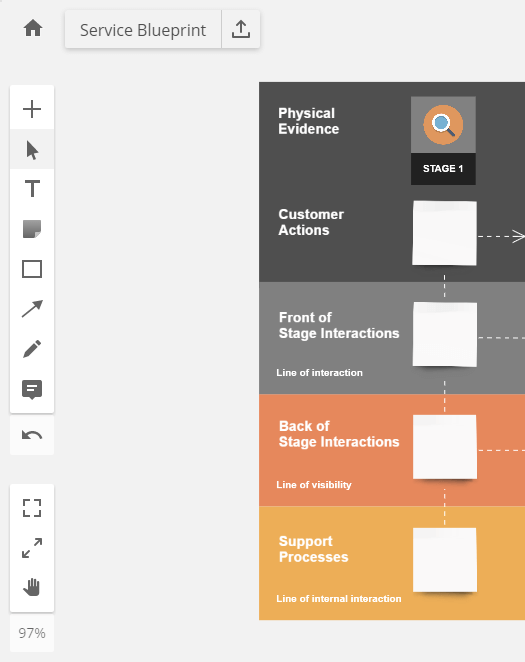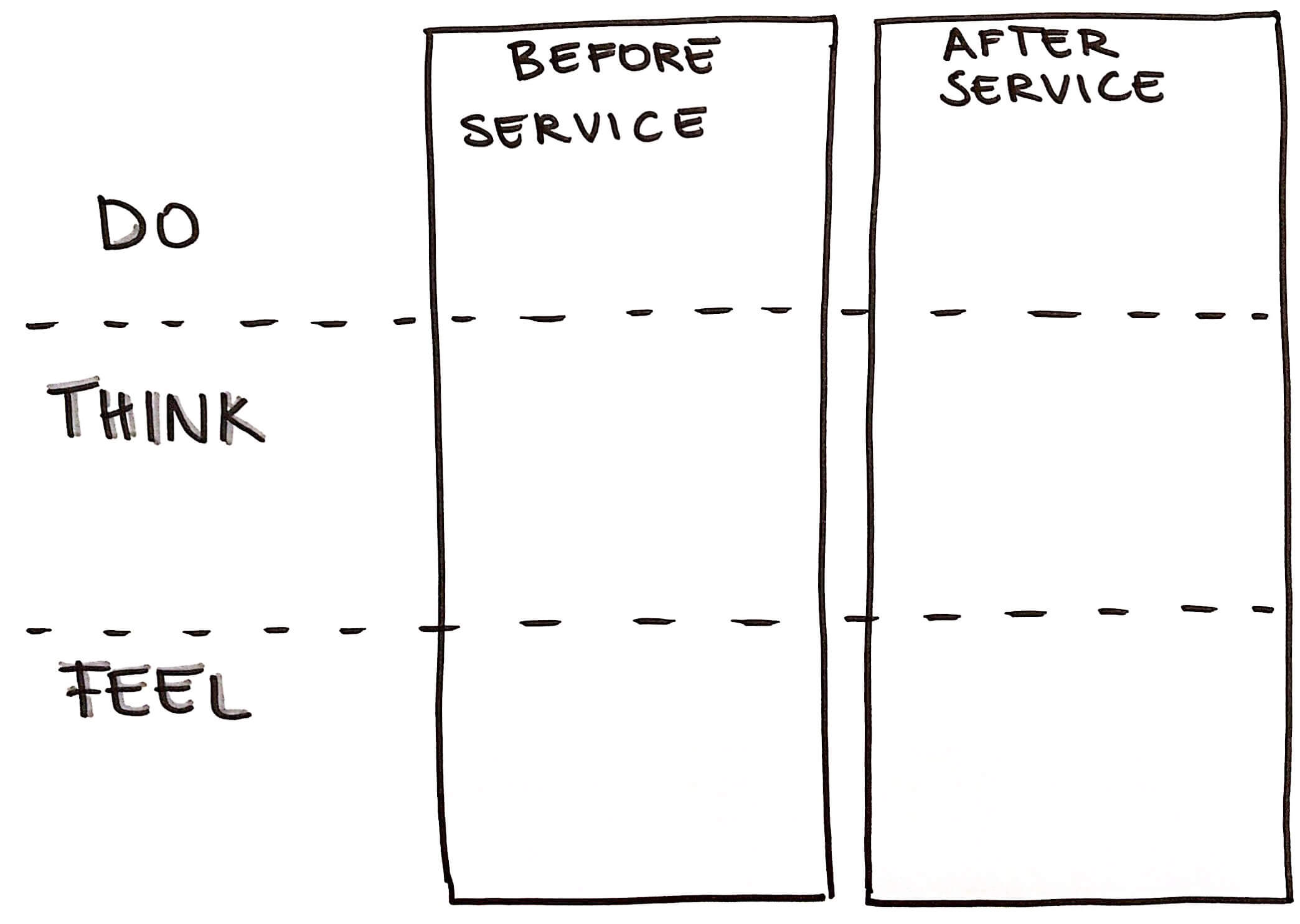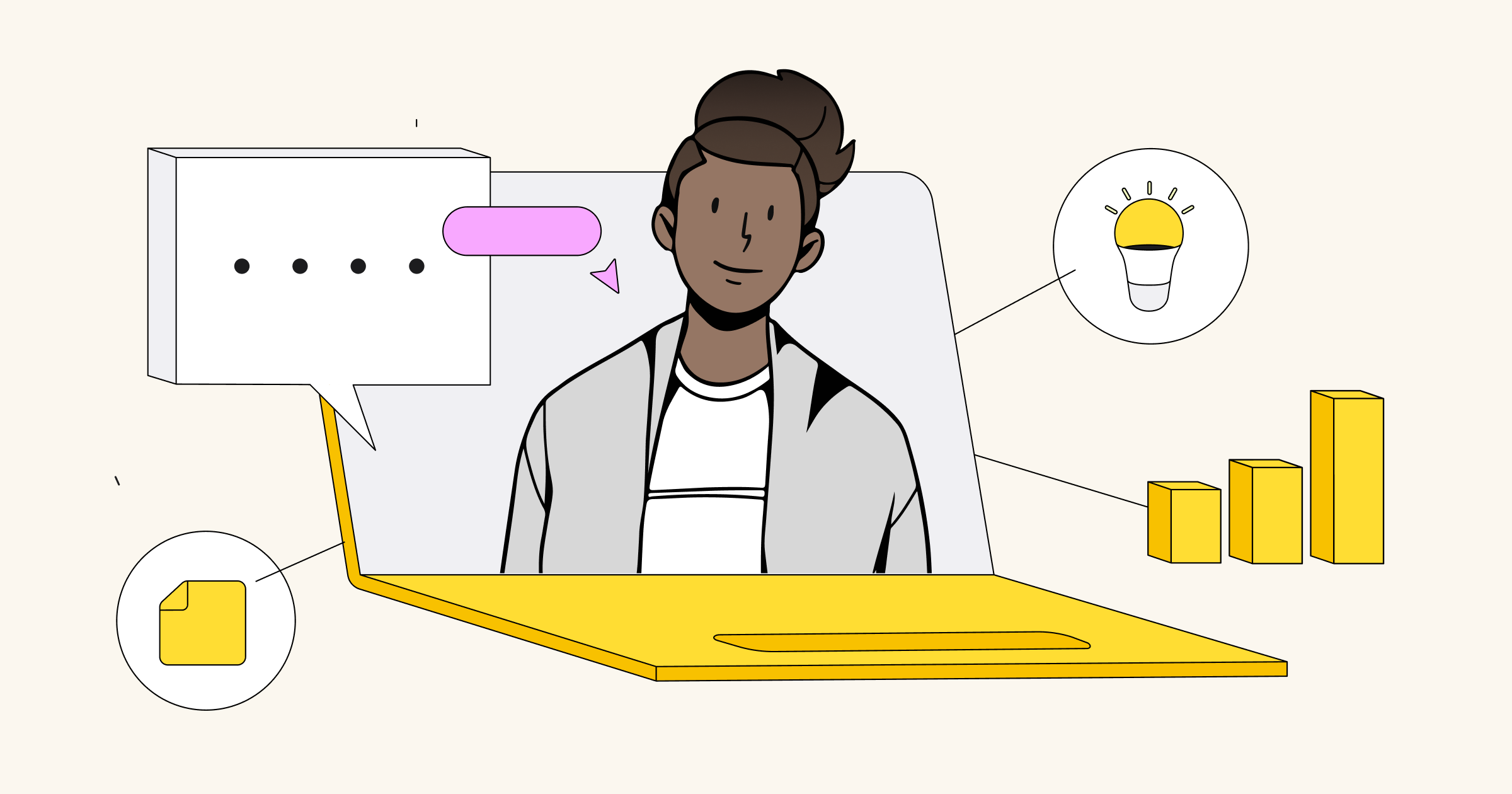This is a guest post by Judit Kertesz, a strategy consultant and design thinker.
Most services seem simple from the outside, but the processes behind the scenes can often be very complex. The aim of a human-centered approach is to design services that reflect the customer’s needs. But examining a service from two points of view — the customer’s perspective and the service provider’s — ensures that digital and human interactions go hand-in-hand.
What is a service blueprint?
Service design has great tools to explain how a service works; one of them is a service blueprint. The service blueprint illustrates a service journey, specifying and detailing the relationships between each aspect of a service along a timeline. One touchpoint on the line of interaction can contain multiple smaller actions in the background.
In other words, a service blueprint is a visual diagram that shows how processes and their components are linked to each other. It incorporates the perspectives of the customers and the relevant departments that may be involved in the implementation. In addition, it allows us to look beyond the service, establish the key user interactions, the role of the service provider and the touchpoints.
Service Blueprint example
It is important to mention that service blueprints do not concentrate on the emotional or motivational side of a service (for that, check out the customer journey map); instead, they provide a graphic visualization of the actions and processes from the service provider’s point of view.
Short explanation of how a service blueprint works
Creating a service blueprint
is a collaborative process
It is easier to reach a shared understanding and achieve a smooth service process when working in collaboration. Different departments can get to know each other’s responsibilities and challenges and see how they influence each other’s deliverables. Service blueprints made in collaboration can help the service provider teams create not only a service roadmap, but also an aligned action plan for each department involved in the service process. Try Miro’s action plan templates.
When to create a service blueprint
A service blueprint draft is often created in the beginning of the service design process.
Most popular use cases for a service blueprint:
- A service understanding, when a company would like to check whether its key processes are sufficiently human-centered
- A service improvement to identify pain points and improve the customer experience
- A service change, when a service needs to be re-designed
- It is easier to show any changes on a blueprint and check the consequences that affect each function
- A service actors understanding, when many departments take part in delivering a customer experience (IT, front office, back office, legal, financial, etc.)
- Transitioning a high-touch service to a low-touch; for example, when you want to design a new cost-effective model with lower audience volume.
Additional use cases for a service blueprint:
- You would like to illustrate the processes and how they interact on one page
- A service has several user interactions
- There might be overlaps between the processes
- You need to calculate the resources and necessities behind the service
Try the Miro service blueprint templates.
Sometimes it can be difficult to decide when to use a customer journey map template and when to use a service blueprint. Both tools visually show the phases and steps of the service, but from two different points of view. A customer journey is based on user research and shows the front stage of the service experience — the user’s motivations, opinions and emotions at each phase of the process. A service blueprint shows the back-stage actions and behind-the-scenes activities along the same process phases. A service blueprint is a classic process map and follows the phases set by the customer journey.
The 5 client interactions with a service
A blueprint scheme usually consists of five basic swim lanes of a client’s interactions with a service and the background processes.
1. The physical evidence
These are the actual communication channels along the service process; for example, webpages, blogposts, event registration and social media.
2. The customer’s actions
These are the actions that the customer has to complete to access the service; for example, reading a blogpost, registering for an event or booking a ticket.
3. Front-of-stage interactions
These are all the tangible online and offline interactions between the service provider and the customer. The direct result of these interactions can be seen by the customer; for example, a chat with the front desk officers, an email interaction, registering for a conference or publishing a post on social media.
4. Back-of-stage interactions
These are all of the things required to produce the service that the customer does not see; for example, writing a blogpost, setting up a service desk or preparing for an event.
5. Support processes
These are the actions that support the process behind the scenes; for example, strategic planning, recruitment and coordination.
Secondary elements to add to a service blueprint
Depending on the complexity of the service, more layers can be added to the blueprint, such as:
- Time
- Emotional journey (based on the customer journey map)
- Multiple touchpoint layers, such as digital and device interactions vs. service employee interactions
- Photos or sketches
- Processes by department
Try to avoid blueprints that are too complex. Too many layers can result in an overly complicated, useless document.
Create my service blueprint
Step-by-step process for blueprints
Let’s have a look at how a service blueprint can be built for a food delivery service. Here is the filled-in service blueprint template to follow:https://miro.com/app/embed/o9J_k0BpY4E=/?autoplay=yep Service Blueprint example
STEP 1. IDENTIFY THE PROCESS TO BE BLUEPRINTED
It is important to focus on one process. In our example, the process is ordering ingredients for a meal, cooking the meal and sharing the experience with others.
STEP 2. IDENTIFY THE USERS OF THE SERVICE AND GET TO KNOW THEIR ACTIONS AND EXPERIENCES
The “physical evidence” (awareness, ordering, etc.) and the customer action lines represent the results of interactions between the customer and the service provider. If there is no customer journey map for the process, make one and illustrate the process from the customer’s point of view.
If you need to visualize multiple services at the same time, it might be better to consider other tools such as journey mapping or process flows.
Step 3. Map and link all the background activities
What is needed to make the service work that the customer does not see? In our example, the main results of the service are smooth delivery and communication processes. The back-stage interactions can include order processing, planning a new campaign, sending engaging emails, etc. Don’t forget to map activities provided by partners.
Step 4. Indicate critical moments and ideas
Add the critical moments and ideas for the users and the service provider.
Step 5. Include measurement where possible
For the food ordering process, the number of repeat orders could be one of the KPIs.
When to add additional indicators to your blueprint
- Moments when the customer makes a decision
- Control points/quality KPI measure points, when the service provider needs to check if the customer got the expected experience
- Opportunities for cost savings
- Pain points and processes that need to be fixed
- The best moments for the customer (positive elements should be visible as well)
Steps to take before mapping a blueprint:
- Know your current state and the service process you would like to map
- Think about the service and define the functions that are involved
- Invite at least one person from all relevant teams (including back-stage and front-stage teams) to the blueprint creation process
- If you are upgrading a service, make sure to include the customer’s pain points
- Identify your customers and key users
- Check the customer journey map and use its elements
- Identify the KPIs that need to be measured and establish goals
The blueprint tool should be flexible and become more detailed during the strategic design process.
Benefits of service blueprinting
Once a service blueprint is ready and we can see the big picture from the service provider’s perspective, it can be used in different situations; for example:
- System maps can be based on service blueprints
- Brief descriptions from each department on the status and next steps can be planned according to the blueprint
- Blueprints can be used when rethinking the business strategy or during the preparation for an organization development process
- Blueprints can be used whenever anyone wants to get know the service quickly (e.g. a new colleague or a service design consultant)
- Blueprints are good tools to discover the service provider’s hidden needs
- Creating a blueprint can also open new windows and uncover new innovation opportunities, by changing the order of activities or eliminating unnecessary ones
Conclusion
A service blueprint is a great tool when you are working with a complex service where many internal processes must be mapped or modified during the design process. Although most companies understand the process when they are illustrated by service blueprints, designers must consider whether there is a real need to prepare a blueprint, since it is a very complex process and not all service design processes need it. If the design team decides to map a blueprint, it is very important to map only one process in a single blueprint to avoid misunderstandings and over-complexity.
Resources:
1. Marc Stickdorn: This is Service Design Thinking (2011);
2. Stefan Moritz: Practical Access to Service Design (2005);





